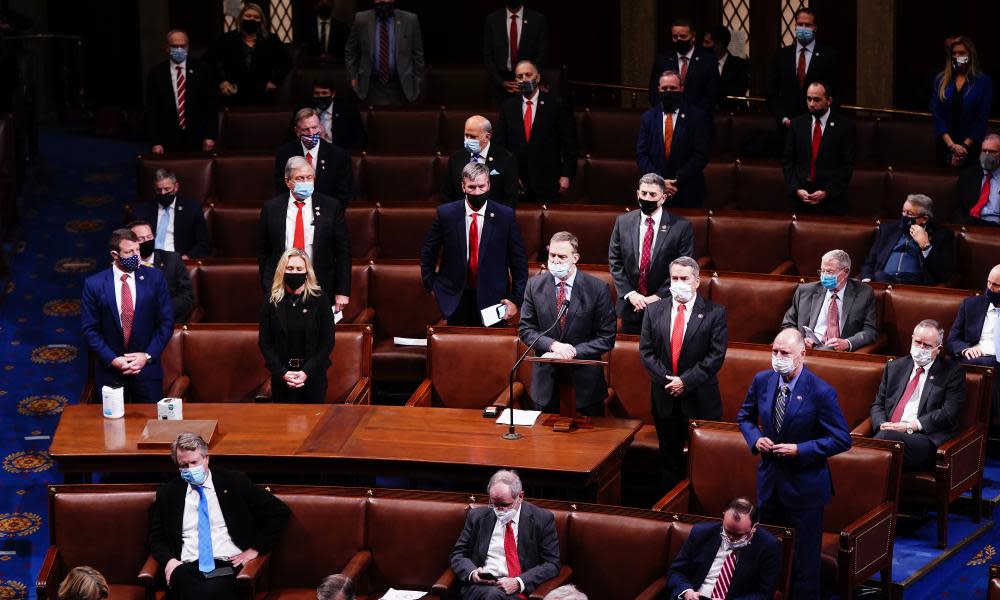White male minority rule pervades politics across the US, research shows

From county officials and sheriffs to governors and senators, white male minority rule pervades politics in the United States, according to a new report published on Wednesday.
White men represent 30% of the population but 62% of officeholders, dominating both chambers of Congress, 42 state legislatures and statewide roles across the nation, the analysis shows.
Related: Just how severe will America's minority rule become? | David Sirota
By contrast, women and people of color constitute 51% and 40% of the US population respectively, but just 31% and 13% of officeholders, according to the research by the Reflective Democracy Campaign, shared exclusively with the Guardian.
“I think if we saw these numbers in another country, we would say there is something very wrong with that political system,” said Brenda Choresi Carter, the campaign’s director.
“We would say, ‘how could that possibly be a democratic system with that kind of demographic mismatch?’”
Two factors perpetuate white male control over virtually every lever of US government: the huge advantage enjoyed by incumbents, and the Republican party’s continued focus on mostly white male candidates.
As the US barrels toward a minority-white population within a matter of decades, some believe elected officials will inevitably become more diverse. But that logic is flawed: women have always been half of the country, and they are still chronically underrepresented in government.
Meanwhile, politicians who currently hold office can make election laws and draw districts in their favor. This legislative cycle, Republican state lawmakers have devised a barrage of new voter restrictions that have targeted left-leaning communities, vulnerable voters and people of color.
“It’s no accident that the pursuit of antidemocratic measures is happening in this moment of really profound demographic change,” Choresi Carter said. “The fact that it’s in that context that efforts to make the United States even less democratic than it already is are happening, that’s not a coincidence.”
But perhaps the greatest testament to the US’s striking power imbalance is who can actually run. Even with women vying for office in record numbers, white men still overwhelm the candidate pool, despite the fact that “primary candidates in all demographics win elections at just about the same rate,” according to the report.
In primaries for statewide office and the House, women and people of color actually do better than their white male opponents, busting a common myth about white men’s “electability” advantage that has often dogged high-profile women’s campaigns.
However, because women and people of color have been largely disenfranchised until relatively recent history, most incumbents are still white men, the report explains. And, during the 2020 primary elections, 96% of incumbents won their races.
Last November, 96% of congressional incumbents held on to their seats, suggesting that officeholders who win their primaries benefit from a similar edge during the general election.
“We have, you know, a political system in general that is not built to include new voices and perspectives. It’s a system built to protect the people and the interests already represented in it,” Choresi Carter said.
“It’s like all systems. It’s built to protect the status quo.”
Voters don't want white male minority rule, yet it's built into the way our elections work. pic.twitter.com/7NiPVwiBZb
— The Reflective Democracy Campaign (@WhoLeadsUs) May 26, 2021
Another obstacle to a more representative government comes from the Republican establishment, which does not run candidates reflective of the nation. In the 2020 primaries, 93% of Republican candidates were white, and fewer than one in four were women.
Democratic candidates, on the other hand, were 44% women and 32% people of color – still shy of a one-to-one match with the country’s overall demographics, but far more inclusive than the GOP’s virtual erasure of entire communities.
That partisan divide – plus the incumbency problem – bolster a cycle where commonsense policies supported by the majority of Americans make little headway, including popular solutions such as gun control, automatic voter registration and universal pre-K education.
“We have this incredibly limited perspective represented in the halls of power when these decisions are being made,” Choresi Carter said.
“And most Americans don’t share that experience, and actually, you know, want different outcomes than they’re seeing.”

